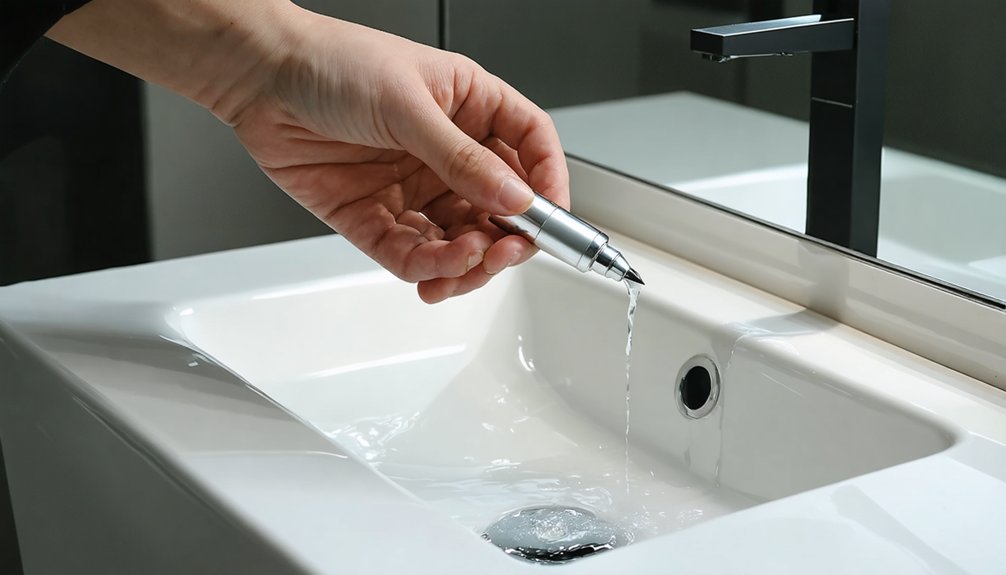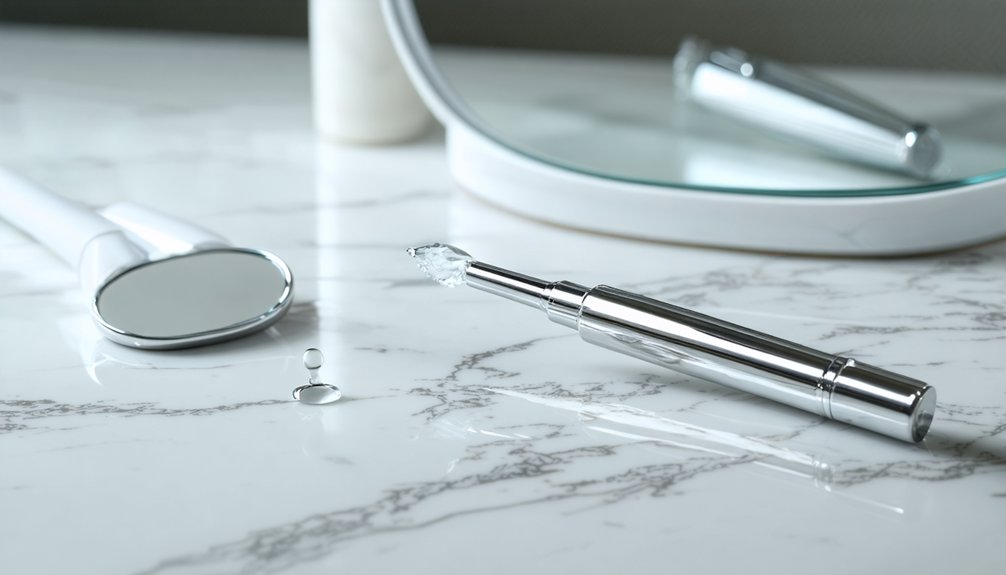Precision whitening pens deliver targeted peroxide gel directly to discolored teeth through a controlled applicator tip. You’ll get noticeable brightening within 7-14 days by applying the 9% hydrogen peroxide formula twice daily after brushing and flossing. The quick-drying gel adheres to specific stained areas while soothing ingredients like aloe vera and coconut oil protect your enamel and reduce sensitivity. Discover how proper application techniques and lifestyle adjustments can maximize your whitening results.
Key Takeaways
- Whitening pens contain 9% hydrogen peroxide that breaks down stain molecules through oxidation, providing up to 5 shades of whitening within a week.
- Precise application requires vertical strokes on dried teeth, focusing on stained areas while avoiding gums, with 30-second drying time.
- Initial results appear within days, with significant whitening after 1-2 weeks of consistent twice-daily use for surface stains.
- Surface stains from coffee and tea show 1-3 shades improvement within two weeks, while tobacco stains benefit from targeted spot treatment.
- Maintain results by rinsing after staining beverages, using straws, and scheduling 3-4 maintenance applications every 2-4 weeks.
Understanding How Whitening Pens Work
While teeth whitening pens may look simple, they rely on sophisticated chemical processes to achieve their brightening effects. The whitening pen mechanism centers on peroxide compounds that penetrate your tooth enamel to break down stain molecules through oxidation.
When you apply the gel, it targets both surface-level and slightly deeper discolorations. Whether using hydrogen or carbamide peroxide, both agents offer comparable whitening performance. These convenient tools provide at-home whitening solutions that can effectively brighten your smile.
Your whitening pen’s peroxide concentration determines how quickly and effectively it’ll work on different types of stains. The pen’s precision applicator lets you control exactly where you place the whitening agent, making it perfect for addressing specific problem areas.
You’ll notice the gel forms a thin, adherent layer that dries quickly on your teeth, allowing the active ingredients to work efficiently without spreading to surrounding tissues or dissolving in saliva.
Key Active Ingredients and Their Benefits
To effectively whiten your teeth, whitening pens harness a powerful combination of active ingredients that work synergistically. The primary active ingredient, hydrogen peroxide at 9% concentration, breaks down stain molecules through oxidation, delivering up to 5 shades of whitening within a week of consistent use. Using whitening pens allows for precise spot treatment of discolored areas.
The ingredient synergy comes from combining this whitening power with soothing agents like aloe vera, coconut oil, and xylitol. These components enhance whitening efficiency while protecting your enamel and reducing sensitivity. Aloe soothes soft tissues, coconut oil provides hydration, and xylitol helps maintain ideal pH balance. The formula is vegan and cruelty-free, making it an ethical choice for conscious consumers.
Supporting ingredients such as glycerin and carbomer guarantee precise application, while peppermint oil delivers a fresh, clean sensation. This carefully balanced formulation maximizes results while minimizing potential irritation.
Step-by-Step Application Guide
Before diving into teeth whitening application, proper preparation guarantees excellent results and safety. Start by thoroughly brushing and flossing, then dry your teeth with a tissue. Verify you’re using fluoride-free toothpaste and your teeth are free of cavities. The pen’s portable design makes it perfect for on-the-go touch-ups.
To achieve ideal gel consistency, hold the pen upright and twist its base until you see the product on the brush tip – usually about seven clicks for first-time use. The pen’s active whitening agents work by breaking down surface stains on your enamel.
Apply the whitening gel using precise, vertical strokes, focusing on stained areas while avoiding gum contact. Your application techniques should maintain even coverage across the tooth surface.
Let the gel dry naturally for 30 seconds to several minutes. Don’t eat or drink for at least 30 minutes afterward.
For best results, you can use the pen twice daily, following your product’s specific guidelines.
Safety Considerations and Best Practices
Since tooth whitening involves chemical agents, understanding proper safety protocols is crucial for achieving optimal results without complications. Select products containing 10% or less hydrogen peroxide and look for approval from recognized dental associations. Dispensing the gel requires precise brush-tip control to ensure targeted application. The rapid-drying formula helps prevent gel migration during treatment.
For ideal sensitivity management, choose formulations with soothing ingredients like aloe vera and xylitol.
Apply the whitening gel using short, vertical strokes, keeping away from your gumline. Make sure your teeth are clean and completely dry before application, and use a thin, even layer to prevent irritation.
Wait at least 30 minutes after treatment before eating or drinking. If you experience severe sensitivity or persistent gum irritation, stop use immediately and consult your dentist.
Consider nighttime application to maximize contact time while minimizing exposure to staining substances.
Results Timeline and Expectations
You’ll notice initial tooth brightening within the first few days of using whitening pens, though significant shade changes typically emerge after 1-2 weeks of consistent application.
Oral hygiene maintenance helps accelerate and optimize your whitening results through consistent brushing and flossing.
Your results’ timeline depends on factors like initial tooth shade, stain type (surface versus deep), and the concentration of active whitening ingredients in your chosen pen. The advanced PAP formula ensures effective whitening without causing tooth sensitivity during the treatment process.
For best outcomes, you’ll need to maintain regular use as directed, typically once or twice daily, while lifestyle choices like coffee consumption and smoking can impact both the speed and extent of whitening.
Week-By-Week Changes
When using teeth whitening pens, understanding the timeline of results helps set realistic expectations for your brightening journey.
During your first week, you’ll likely notice subtle changes while maintaining proper application frequency of 1-2 times daily.
Your user experience might include mild sensitivity or gum irritation as your teeth adjust to the treatment.
Factors Affecting Speed
The speed and effectiveness of teeth whitening pens depend on several key factors that can greatly impact your results. The concentration of the whitening agent, whether it’s hydrogen peroxide or carbamide peroxide, directly influences how quickly you’ll see changes. Higher concentrations typically work faster but may increase sensitivity.
Your application frequency and consistency play vital roles in the timeline. While most users notice changes within 7-14 days, deeper stains require more prolonged treatment.
The type and severity of your stains greatly affect the speed of results – surface stains from coffee or wine respond more quickly than intrinsic discoloration.
For best results, maintain regular applications as directed, and remember that individual factors like dental health and stain penetration will determine your specific whitening timeline.
Comparing Whitening Pen Effectiveness
You’ll find whitening pens most effective on surface stains from coffee, tea, and wine, though they’re less impactful on deeper, intrinsic discoloration from medications or aging.
The application time directly correlates with results – consistent daily use for 7-14 days typically yields 1-2 shades of improvement for surface stains.
While some pens claim dramatic results in shorter periods, clinical evidence suggests that longer treatment durations of 2-4 weeks provide more reliable and lasting whitening effects.
Results by Stain Type
Understanding how whitening pens perform against different types of dental stains helps set realistic expectations for results.
You’ll find these pens most effective on surface stains from coffee, tea, and tobacco, typically achieving 1-3 shades of improvement within two weeks.
For intrinsic stains and age-related discoloration, you’ll need professional treatments, as pens primarily target the enamel’s surface rather than deeper dentin layers.
- Surface stains respond best to precise pen application, with noticeable results in 7 days of consistent use.
- Coffee and tea stains require repeated applications over several weeks for ideal whitening.
- Tobacco stains show visible improvement with targeted spot treatment using whitening pens.
- Age-related yellowing benefits from pens as a maintenance strategy after professional whitening.
Application vs. Treatment Time
Maximizing whitening pen effectiveness requires balancing application convenience with proper treatment duration.
While application methods take just seconds per tooth, you’ll need to maintain consistent treatment intervals over 1-2 weeks for ideal results. Quick-drying formulas let you apply and resume activities within minutes, but the active ingredients continue working for 20-30 minutes after application.
You can choose between once or twice daily applications for standard formulas, while advanced products allow up to four daily treatments to accelerate whitening.
Be mindful that extending contact time beyond recommendations won’t enhance results and may increase sensitivity. For best outcomes, you’ll want to follow the manufacturer’s prescribed frequency while avoiding food and drink during the initial drying period.
Tips for Maintaining Your Brightened Smile

After investing time and effort in achieving a brighter smile, maintaining those pearly white results requires a strategic combination of proper oral care, lifestyle adjustments, and periodic touch-ups.
Your daily oral hygiene routine and dietary habits play vital roles in preserving your whitening results. Brush twice daily with fluoride toothpaste, floss regularly, and use an antibacterial mouthwash to prevent stain-causing plaque buildup.
- Rinse immediately after consuming staining beverages and use a straw when possible
- Schedule professional cleanings every six months to remove surface stains
- Follow a maintenance schedule of 3-4 applications every 2-4 weeks, as recommended
- Limit exposure to staining agents like coffee, tea, red wine, and tobacco products
Frequently Asked Questions
Can Whitening Pens Be Used on Dental Crowns or Veneers?
Like water off a duck’s back, whitening pens won’t affect your crowns or veneers. You’ll find these dental restorations aren’t compatible with whitening chemicals, and their color stays unchanged despite treatment.
How Long Should I Wait After Teeth Cleaning Before Using Whitening Pens?
You’ll want to wait at least 24 hours after cleaning to minimize teeth sensitivity. Check with your dentist about whitening frequency, as individual recovery times vary based on your enamel’s condition.
Are Whitening Pens Safe to Use During Pregnancy or While Breastfeeding?
Due to safety concerns and pregnancy guidelines, you shouldn’t use whitening pens while pregnant or breastfeeding. Instead, maintain regular dental hygiene and wait until after these periods to pursue whitening treatments.
Can Teenagers Safely Use Teeth Whitening Pens?
Due to safety concerns with developing teeth, you shouldn’t use whitening pens until age 14-16. Consult your dentist first, as young teeth are more sensitive to peroxide-based whitening treatments.
Do Whitening Pens Work Effectively on Teeth Stained by Antibiotics?
Whitening pens won’t effectively remove deep antibiotic stains, especially tetracycline-caused discoloration. You’ll see limited whitening effectiveness on surface-level antibiotic stains, but professional treatments offer better results for intrinsic discoloration.
References
- https://g-p-dental.com/whitening-pens-put-to-the-test-see-what-works/
- https://www.genesispub.org/evaluating-the-effectiveness-of-two-whitening-formulations-and-a-barrier-gel-pen-an-ex-vivo-study
- https://www.futuremarketinsights.com/reports/teeth-whitening-pens-market
- https://burstoralcare.com/products/precision-whitening-pen
- https://www.urbandentalstudio.com/post/do-teeth-whitening-pens-really-work/
- https://pmc.ncbi.nlm.nih.gov/articles/PMC10812912/
- https://crest.com/en-us/oral-care-tips/teeth-stains/how-does-a-teeth-whitening-pen-work
- https://inlandchoicedental.com/does-teeth-whitening-pen-actually-work/
- https://loudoundentalassociates.com/what-are-teeth-whitening-pens/
- https://www.directteethwhitening.io/how-do-teeth-whitening-pens-work/



